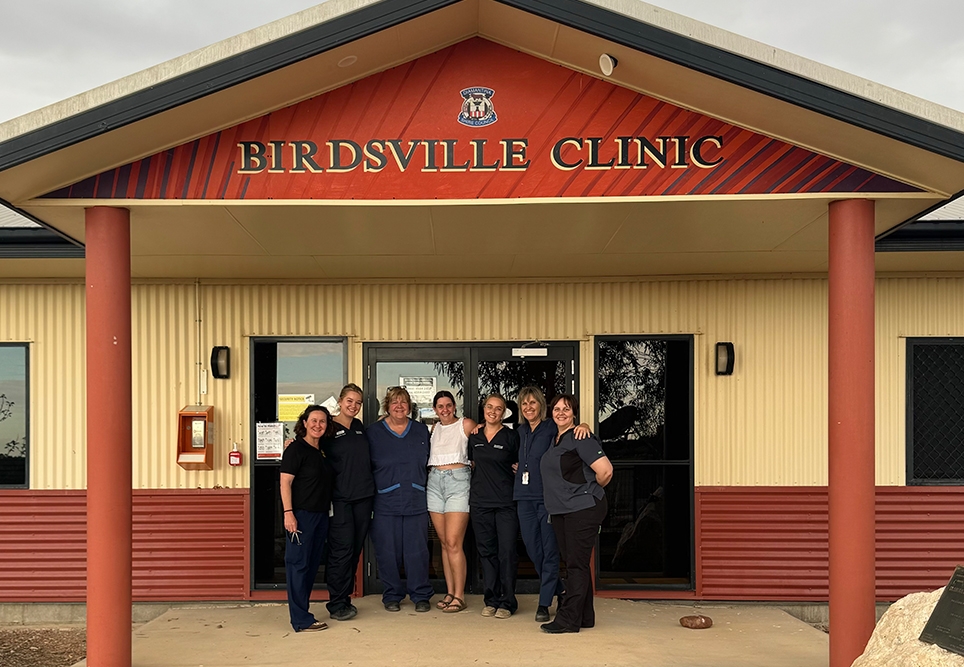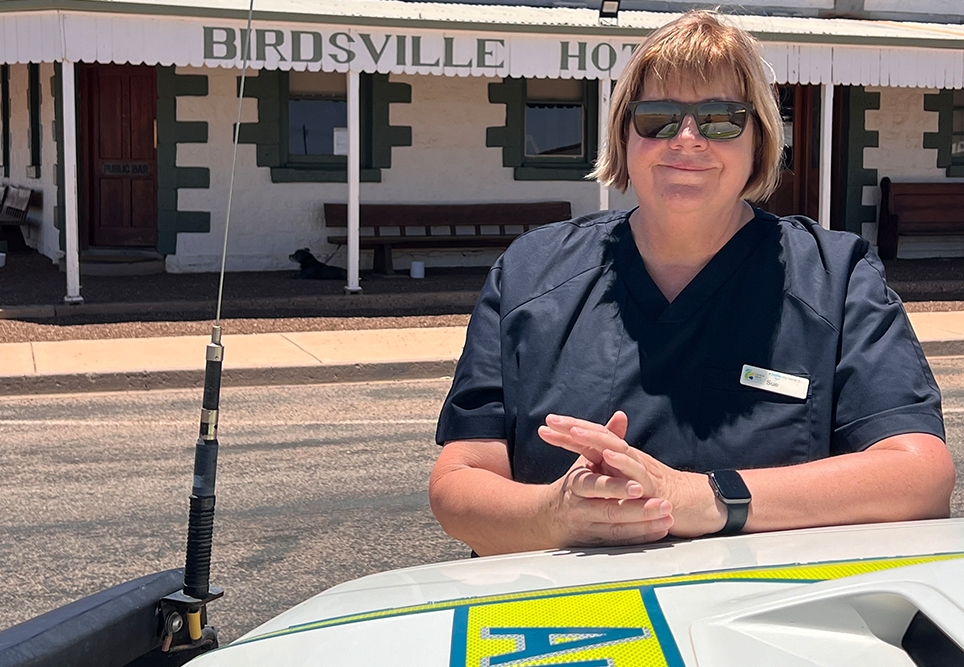This site may not work properly using older versions of Edge and Internet Explorer. You should upgrade your browser to the latest Chrome, Firefox, Edge, Safari, or any other modern browser of your choice. Click here for more information.
Your Stories
This is where we tell your stories, cover topical issues and promote meaningful initiatives.
The Nutbush has its limits
Susan Wilkes, the Director of Nursing at the Birdsville Primary Health Centre, Central West Hospital and Health Service – which is a part of Queensland Health – was a presenter at this year’s conference on dealing with medical challenges at mass gatherings.
Ms Wilkes (pictured right) also was the recipient of the CRANAplus Excellence in Remote and Isolated Health Practice Award.
When we think of mass sport and music gatherings in outback Australia, Birdsville on the edge of the Simpson Desert soon comes to mind.
Think of the challenges facing nurses as tourists gather for these events, and motorbike accidents will pop up as a strong contender.
Not so obvious, however, but high on the risk assessment list at the Big Red Bash in Birdsville (pictured below) is the over-zealous response from Nutbush enthusiasts taking up the festival call to strut their stuff as the music starts.
“Desert sand and Nutbush may not be the best combination,” Sue told the audience at the conference during her presentation to share the lessons learned from mass gathering events in Birdsville and the impact it has on the healthcare services and community.
“Interesting fact about the Nutbush, it can be considered a high-risk dance as the last two years has seen broken bones, sprains and cardiac issues, just to name a few presentations.’’
Birdsville, smack in the middle of Australia, has a population of 106 according to the 2021 Census. That figure can fall to about 60 in the summer, says Sue.
“So, while the music festival and the Birdsville Races attract many thousands of people, the small events also have a big impact on the town, as well as on the Birdsville Primary Health Centre and Central West Hospital and Health Service,’’ she says.
“The population can triple for the weekend with events that attract a few hundred people, such as Bronco Branding, the rodeo, the Simpson Desert Ultra, golf events and car rallies.
“While some will say they are not mass gathering events, the increase in population will have a significant impact on the nurse’s ability to provide safe care. Whether it’s a rodeo with 300 people or 12,000 people for a music festival, the impact on the health service and community is significant.’’
Sue’s conference presentation outlined the collaborative effort by the whole community to handle mass gatherings, listing numerous agencies and individuals involved, ranging from the event organisers and security to the Royal Flying Doctor Service and police officers, fire service and SES volunteers, the shire council and locals, as well as Birdsville Primary Health Centre staff and the Central West Hospital and Health Service of which the health centre is a part.
“We all work together to give the tourists the best experience possible,’’ says Sue.
Unknown to Sue as she spoke, she had been nominated by her work colleagues for the Excellence in Remote and Isolated Health Practice Award, the nomination emphasising her commitment to everyone in the Birdsville community: local patients, clinic staff, volunteers and other agencies in town; along with tourists, event participants and visitors.
The nomination began by stating that Sue, an experienced Registered Nurse and Midwife, “demonstrates a depth of knowledge and skills at an advanced practitioner level in a rural and remote setting with limited resources. Susan is a strong advocate for patients – particularly in ensuring access to appropriately skilled staff to ensure their ongoing health and wellness along with emergency care response to locals and visitors alike. This includes throughout mass gatherings and events.’’
Over the last three tourist seasons, Sue has been involved in making significant changes in planning and preparing for events, both large and small. Interagency planning is part of the collaborative approach.
“I am already starting to prepare for 2025, locking in staff so flights and accommodation can be booked,’’ she says.
Sue has also turned her attention to calculate the correct staffing ratio for a mass gathering event held in these small remote communities.
In 2023, the music festival had multiple paramedics and a doctor onsite and in 2024 they changed their focus of medical care to doctors, nurses and paramedics. Even with an increase in medical coverage at the music festival, the clinic in town had more presentations this year, even though crowd numbers were down by thousands.
At the Birdsville Races (pictured left), the clinic is the only access point for medical care, and while the numbers are less than half of the music festival, the number of presentations and retrievals are similar, therefore requiring the same staffing numbers for both events.
“We are continuing to collect data to allow us to support the arguments towards an evidence-based model,” says Sue.
“Informed by the elements of safety for mass gathering events in remote environments.
“We are doing this in collaboration with Professor Pauline Calleja, James Cook University, to inform an evidence-based workforce model in rural and remote environments in mass gathering events.’’
The additional staff that Sue brings out to Birdsville is comprised of senior clinicians who know Birdsville and can support other nurses with an interest in developing remote area nursing skills.
“This team can therefore take care of the community as well as respond to the additional clinical demand that mass gatherings and large visitor numbers bring in a very remote environment,’’ she says.
“With the graduate nurses coming out, there is an opportunity for the transfer of skills. For example, nurses coming out before the event itself have a chance to learn how a remote clinic operates, an opportunity to experience day-to-day running.
“This will include liaising with the RFDS, responding to ambulance callouts, and providing primary health care for the whole community. It doesn’t stop.
“They get exposure and experience with outback situations and develop their skillset – and we do get a lot of motorbike incidents.
“Two of the girls have asked to come back next year to work during the tourist season to gain more experience in the primary healthcare setting.’’
As her nomination stated: “Sue has additionally demonstrated a profound and lasting contribution to the professional growth of junior nurses through her mentorship and guidance. Sue encourages colleagues to grow within their role offering support, education and guidance, and is known for her integrity, excellence, inclusivity, respect and social justice.’’
Sue has been nursing for 35 years.
I’ve always gone back to the Bush, she says, pointing out that she is a country kid, having grown up on a dairy farm, she said.
Starting as an Enrolled Nurse working in places like Goondiwindi, she then trained through university to be a Registered Nurse.
“I spent some time in the big smoke in Melbourne in emergency and ICU, consolidating my skill set,’’ she says.
“I then worked as an agency nurse in many parts of Australia, before training as a midwife and heading back to outback Queensland to work.’’
Sue came back to Birdsville in 2022 to do some relief work for the Central West Hospital and Health Service – and stayed.
“This is a very inclusive community, very supportive of myself and the other nurses,’’ she says.
So, it is no surprise that Sue’s nomination also emphasised her “strong bond with her community, going the extra mile, not because it’s required but because it is the right thing to do’’.




